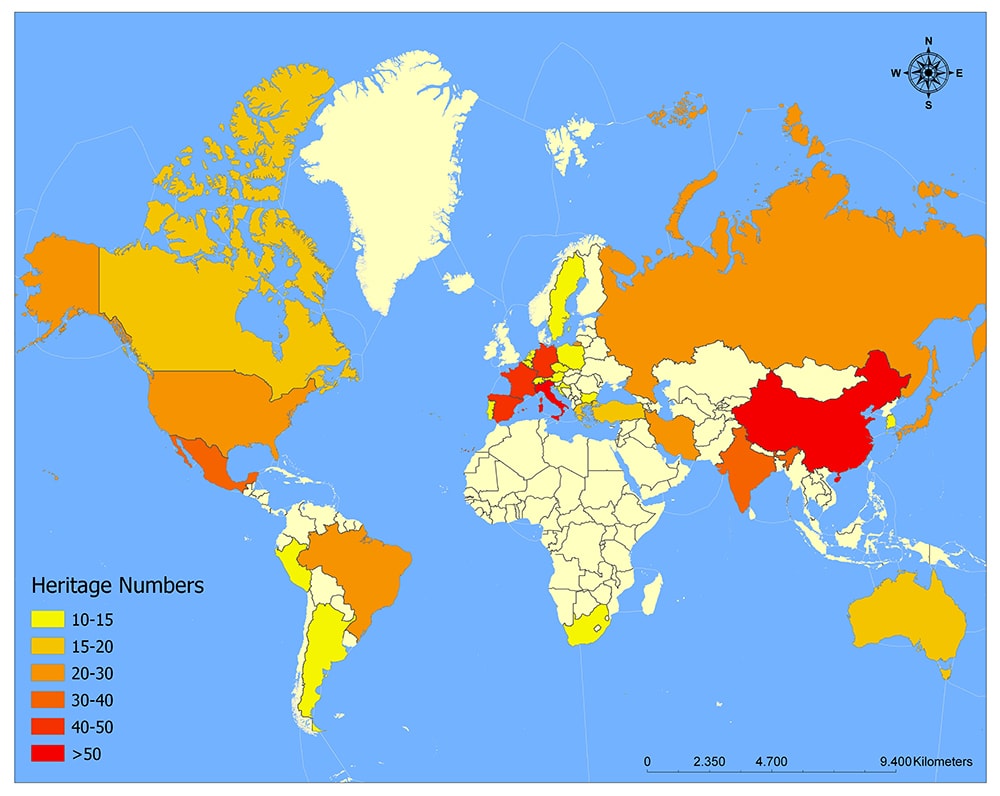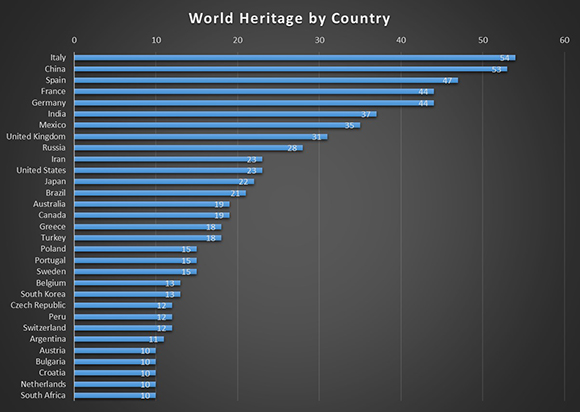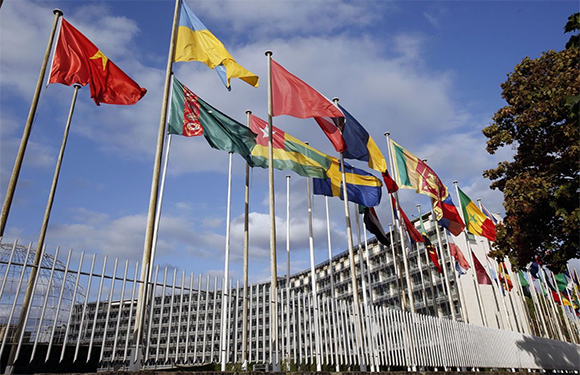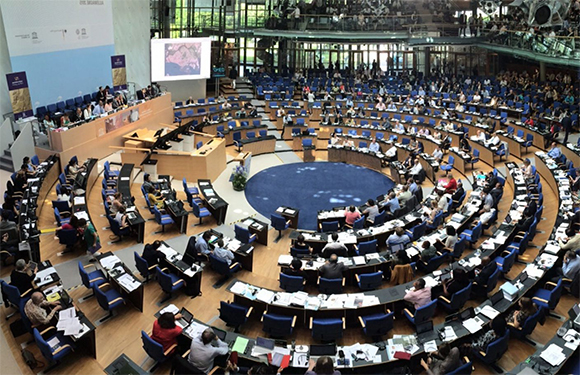The countries with the most world heritage are sites are Italy, China, Spain, France, Germany.
Here is a map showing the number of UNESCO world heritages by country:
UNESCO World Heritage World Map

Below, you can see the graph with the number of world heritages:

1. Italy
There are 53 world heritage sites in Italy. As the birthplace of the Roman Empire and the Renaissance, Italy has the highest number of World Heritage sites in the world.
These include the Dolomites, the city of Venice and its lagoons, the city of Verona, the Santa Maria Delle Grazie with the Leonardo da Vinci’s Last Supper table in Milan, the Duomo Square in Pisa, the historic center in Rome and many more.
2. China
There are 52 world heritage sites in China. It is the birthplace of one of the oldest civilizations in the world and many dynasties.
It hosts many cultural sites, including the Great Wall of China in Beijing.
Some World Heritage Sites of the People’s Republic of China are also listed as follows: Chengjiang Fossil Site, the historical center of Macau, Dazu Rock Carvings in Chongqing, and the Temple of Heaven in Beijing.
3. Spain
There are 46 world heritage sites in Spain. Spain has a strong cultural heritage, including the Roman Empire. Some of these are the historical center of Cordoba, the Alhambra in Granada, the Park Güell in Antoni Gaudi, Barcelona, the Alcazar in Seville, the biodiversity and culture in Ibiza.
4. France
There are 43 world heritage sites in France. France has a history dating back to the Frank tribes in the Roman Period, the French Empire and its powerful rulers. Some of the World Heritage sites are the Notre Dame Cathedral in Paris and the Palace of Versailles, Loire Valley, Fontainebleau Park, and Palace, and the Gard Bridge in Occitane.
5. Germany
Germany has 40 sites registered in the UNESCO World Heritage List. The Aachen Cathedral in Aachen, the caves in the Swabian Jurassic in Baden and the art of the Ice Age, the Town Hall in Bremen, the Cologne Cathedral, the fossil area in the Messel and the Museum Island in Berlin are some of these.
You can find a full and up-to-date list on the official UNESCO World Heritage List website.
About UNESCO
United Nations Educational, Scientific and Cultural Organization (UNESCO) was founded in 1945 and is a specialized organization of the United Nations.
UNESCO has 190 countries. Mr. Koichiro Matsuura is the General Director.
UNESCO has been established among the member countries to improve cooperation in the fields of education, science, and culture, to exchange ideas and to contribute to the standardization of relevant issues.
The UNESCO General Conference meets in Paris every 2 years. The meetings held within the framework of the Convention on the Protection of the Intangible Heritage and the Convention on Cultural Diversity, which UNESCO attaches importance recently, are conducted 4-5 times a year.
The UNESCO budget is provided by the dues paid by the member states every two years. Apart from this budget, the United Nations Special Fund also has other sources of funds, especially technical assistance programs.
What Does Unesco Mean and What Does it Do?

UNESCO’s stands for United Nations Educational Scientific and Cultural Organization.
It aims to realize cooperation in the fields of education, science and culture in the fields of international relations and to provide convergence.
Reducing the number of illiterates, helping schools and libraries, organizing cultural events for underdeveloped countries can be cited as examples of UNESCO’s work.
The organization is completely independent of its organs, budget and other status, except for reporting to the United Nations. Every UN member state has the right to be a member of UNESCO.
The organization has three organs parallel to the UN. These are the General Conference, the Executive Committee and the Secretariat.
General Conference
The General Conference, consisting of the representatives of 195 member states, convened every year between 1946 and 1953, and began to convene every two years after 1954.
Non-member states, intergovernmental and non-governmental organizations may also monitor the General Conference as an observer, although member states participate in their meetings.
The General Conference, which sets out the organization’s policies and basic working plan, is also the most competent body of UNESCO. The General Conference has also the right to elect members of the Executive Committee and the General Director.
Executive Board
UNESCO’s Executive Board assumes the general management, prepares the work of the General Conference and practices are followed. Elected by the General Conference and the term of office of four years, consisting of 58 member Executive Committee meets two times a year.
Secretariat
The Secretariat is composed of a General Director elected by the General Conference for 6 years and the staff appointed by him. As of 2009, the General Director is Audrey Azoulay, who currently serves in the Secretariat with approximately 2000 employees from around 170 countries.
Activities of UNESCO
We can say the following about UNESCO’s duties. To increase the literacy rate in the world, to regulate the educational level of countries, to provide international peace, to train teachers who will work in basic and technical education, to support important art events, to help the researches to develop communication tools related to art such as theater, cinema television and press.
For example, UNESCO offers basic education courses for adults in various states every year to increase the literacy rate.
The Education Clearing House, which is affiliated with the organization, works in Paris and publishes its three-year-long publication, World Survey of Education. In addition, the arid regions program was one of the most important projects of the institution in the late 1950s and significant works were put into practice.
World Heritage Committee

The World Heritage Committee is the board that determines the sites to be listed as a UNESCO World Heritage Site.
It is responsible for the implementation of the Convention on the Protection of the World Cultural and Natural Heritage, governs the use of the World Heritage Fund, and distributes financial assistance upon the request of the States Parties. It consists of twenty-one States Parties elected by the General Assembly of the United Nations for four years.
The memory of the World
The World Memory Program of UNESCO’s Information and Communication Sector, under the theme of Building Information Societies, has been continuing its activities since 1992.
The World Memory Program held its first meeting in Pultusk, Poland in 1993 and since then the experts have been meeting regularly every two years.
The aim of the program is to protect the documents and information which constitute the historical, cultural and social memory of mankind and which are at risk of disappearance by various natural disasters or social reasons, such as wars, and to share them as one of the measures of this protection in the digital environment.
The World Memory Program has three main objectives:
- To facilitate the protection of the world’s documentary heritage with the most appropriate techniques,
- Assisting in universal access to documentary heritage,
- To raise awareness of the existence and importance of documentary heritage worldwide.
The most visible aspect of the program, the World Memory Register was created in 1995. The first record in the World Memory Register was taken in 1997.
UNESCO World Heritage List
UNESCO (United Nations Educational, Scientific and Cultural Organization) is a protected area management unit established in 1964.
This unit has places listed as World Heritage in various geographies of the world.
A city, a forest, a mountain, and a monument can be found in those places. UNESCO currently has 21 committee member countries, and the World Heritage Committee is updating its World Heritage List.
Although there are four conditions for entering into this list until 2004, these conditions were increased to 10 with a change in 2005.
According to this, the areas that must have superior universal values to enter the World Heritage List are obliged to provide at least one of the 10 criteria.
Among these criteria, there are two parts, as cultural and natural criteria.
Cultural Criteria
- It is the product of creative human genius.
- To demonstrate the important interaction between human values in a certain period of time or in a cultural place, in the development of architecture or technology, in the development of monumental arts, in the planning of cities or in the creation of landscapes.
- A cultural tradition or a single or at least exceptional testimony of living or lost civilization.
- Providing a valuable example of the type of building or architectural or technological landscape community representing one or more meaningful periods of human history.
- Providing an important example of the use of traditional human settlements or land that represent one or more cultures and in particular the loss of its durability due to irreversible changes.
- It is either directly or concretely linked to events or living traditions, ideas, beliefs or artistic and literary works that have a universal meaning.
Natural Criteria
- Natural wonders or unique beauty and aesthetic importance.
- Having unique knowledge of the natural history of the Earth, such as the remains of living creatures, the ongoing geological events and the development of landforms.
- Host a terrestrial, marine or freshwater ecosystem or important animal and plant communities that are still ecologically and biologically intact.
- Hosts the most important and prominent natural habitats, especially for endangered or scientifically important biodiversity.